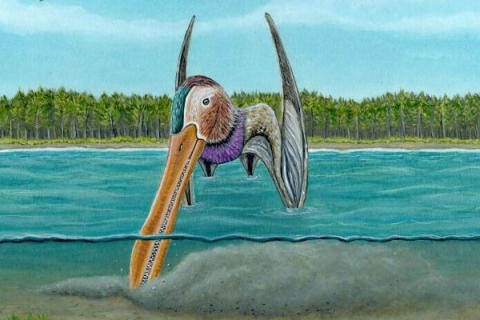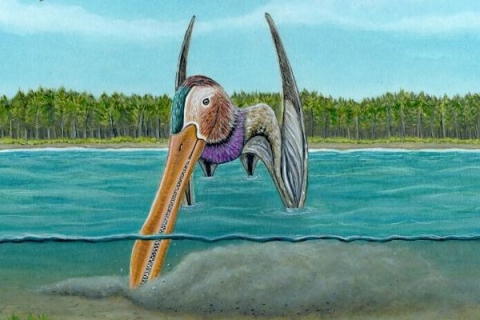

Scientists have discovered that pterosaurs used the sensitive tip of their beak to find food.
15 September 2020
6 min read
Pterosaurs - winged cousins of dinosaurs - evolved sensitive beaks to allow them to find food, like modern birds such as ducks, sandpipers and kiwis, according to a new paper by the universities of Portsmouth and Bath.
Pterosaurs lived in the age of dinosaurs and existed for an incredible span of time - more than 100 million years. The largest weighed hundreds of kilos and had wingspans of 10 metres or more, similar in size to a small aeroplane like a Spitfire.
These flying reptiles were previously thought to have used their large eyes to hunt, before seizing food with their jaws or spearing it with sharp beaks. But now scientists have shown that some species of pterosaur used the sensitive tip of their beak to find food.
The fossils are from the species Lonchodraco giganteus, found in a chalk pit near Kent in southern Victorian England. Although the fossils were first discovered in 1846, their remarkable nature wasn’t noticed until Professor David Martill from the University of Portsmouth restudied the animal at the Natural History Museum in London.

An artist’s impression of Lonchodraco giganteus by Megan Jacobs, University of Portsmouth.
Professor Martill said: “This new find hints that, like birds, the pterosaurs evolved a huge range of feeding strategies - including ways of finding their prey. Many pterosaurs would have used their sharp eyes to pick out prey on the wing, while stalking it on the ground. But this species apparently used the sensitive beak to find prey by touch - feeding on the ground and probing around in shallow water like a dabbling duck or spoonbill, perhaps even feeding at night. These animals could probably detect a fish in the muddiest of water.”
Professor Martill’s research revealed dozens of tiny holes in the tip of the beak, where the nerves passed through the bone. Clusters of nerves are not known from other pterosaurs, but are seen in the beaks of birds like kiwis, sandpapers, snipes and spoonbills, ducks and geese, ostriches and the extinct dodo. These birds rely heavily on their sense of touch when finding and catching food. Typically, they either probe in water and mud for food or feed on plants, using electrical signals to sense prey.
I had always thought that pterosaurs found their prey using their excellent eyesight, but it seems they had other acute senses too.
Roy Smith, University of Portsmouth PhD student
University of Portsmouth PhD student, Roy Smith, who co-authored the paper, said: “I had always thought that pterosaurs found their prey using their excellent eyesight, but it seems they had other acute senses too. This study is particularly fascinating because it does suggest that some species of pterosaur could have been nocturnal, like bats today.”
Dr Nick Longrich from the University of Bath said: “The new find challenges our assumptions about the pterosaurs, and shows just how diverse they were. We often picture pterosaurs hunting on the wing and grabbing fish, like modern seagulls. Many probably did, but fossils give us a biased picture. Since most of the pterosaur fossils are from lakes, lagoons and seas, we find a lot of the pterosaurs that hunt over water. There’s a similar problem with birds - we have a much better fossil record for seabirds than hummingbirds, for example. Pterosaurs clearly evolved a huge range of feeding habits, and rare finds like Lonchodraco hint at that.”
The new paper is published in Cretaceous Research.
